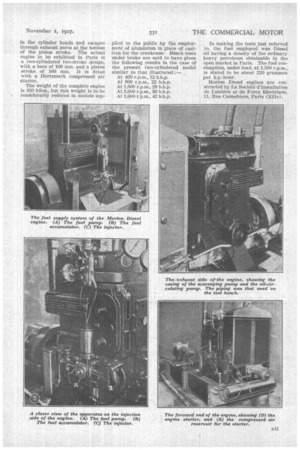A NEW DIESEL ENGINE FOR HEAVY VEHICLES.
Page 58

Page 59

If you've noticed an error in this article please click here to report it so we can fix it.
A French Product Which Has Proved Under Test to Possess a High
Degree of Flexibility.
A N interesting new French light _C1_Diesel engine, suited to industrial vehicle work is being exhibited, under power, at the International Salon Nantique, which opened in Paris last week. This is the Morton, an engine designed on orthodox Diesel lines, but possessing an unusual degree of flexibility. When under load the speed of the Morton an be varied from -500 r.p.m. to 1,500 ray.m., a variation which approximates very closely to that obtainable with the normal type of petrol engine employed in commercial work.
Before: its appearance on the market the Morton had been the subject of si x years' constant experime.ntal work, and it is said to have given very satisfactory results on the bench.
A special feature of the engine is the system of
fuel supply and injection. This comprises a reciprocating fuel pump, a hydraulic accumulator and a rather curious form of injector. Referring to the diagram, Fig. 1 shows the oil fuel pump. This is an ordinary reciprocating pump driven by an eccentric and fitted with ball valves. Fig. 2 is the accumulator, in which the fuel is temporarily stored under pressure while on its war to the -engine. A constant pressure is maintained is the accuMulator -chamber by means of the spring-loaded plunger (g). An escape valve through which surplus oil can return to the tank is shown at (1). • Fig. 3 shows the injector. Fuel entering at (m) is adinitted .tc the cylinder br means of a mechanie cally operated valve, through a venturi type of opening (n). At the moment that the fuel valve opens, a second valve (p) admits compressed
air,which mingles with the fuel and assists in its diffusion. Both air and fuel valves . are operated by the same cam.
The air for the injector is supplied by a separate pump which is quite independent of the main scavenging 1 ' air punip. .The kittter is exterior to the crank' chamber and delivers clean air to the cylinders: The main air enters by valves in the cylinder heads and escapes through exhaust ports at the bottom of the piston stroke. The actual engine to be exhibited in Paris is a two-cylindered two-stroke design, with a bore of 100 mm. and a piston stroke of 160 nun. It is fitted with a Hertzmark compressed air starter.
The weight of the complete engine is 350 kilos., but this weight is to be considerably reduced in models sup
plied to the public by the employment of aluminium in place of castiron for the crankcase. Bench tests under brake are said to have given the following results in the case of the present two-cylindered model similar to that illustrated At 450 r.p.m., 12 b.h.p.
At 800 r.p.m., 22 b.h.p.
At 1,000 r.p.m., 28 b.h.p.
At 1,300 r.p.m., 36 b.h.p.
At 1,600 r.p.m., 42 b.h.p. In making the tests just referred to, the fuel employed was Diesel oil having a density of the ordinary heavy petroleum obtainable in the open market in Paris. The fuel consumption, under load, at 1,500 r.p.m., is stated to be about 220 grammes per h.p.-hour.
Morton Diesel engines are constructed by La Societe d'Installation de Lumiere et de Force Electrique, 11, Itue Cannebiere, Paris (XIIe).




































































































